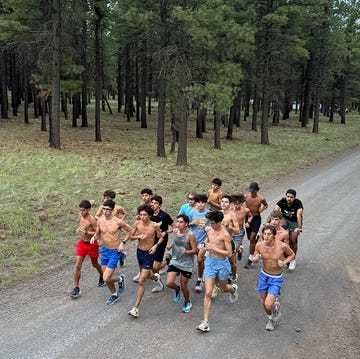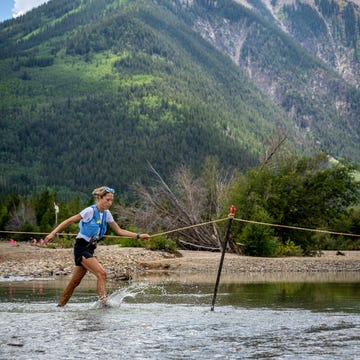It’s been 50 years since America lost one of its greatest distance running legends, but Michael Marckx can still feel the ache of losing his boyhood idol.
Steve Prefontaine was only 24 when he died in a car accident in Eugene, Oregon, early on the morning of May 30, 1975, but his legacy has remained galvanized in American running culture. Known simply as “Pre,” to his fans and followers, he held every American record from 2,000 meters to 10,000 meters, and, after finishing a disappointing fourth in the 5,000 meters at the 1972 Olympics, he was hellbent on earning redemption at the 1976 Games in Montreal.
Although Marckx was only 10 at the time of Prefontaine’s tragic death, Marckx was already on his way to becoming an avid runner himself, thanks in part to those early interactions with the guy he knew as “Uncle Steve.”
Marckx is the nephew of Mary Marckx Creel, who was the girlfriend of Prefontaine while they were both undergraduates at the University of Oregon, and he had become a fan and friend of Pre in the preceding years because the legendary track star would stay at his parents house in Palos Verdes, California, when he would race in Los Angeles. He and his family watched Prefontaine race several times and on a few occasions accompanied him to the local high school track to watch him do his workouts.
“I’ll never forget the morning my mom woke me up to tell me that Uncle Steve had died,” said Marckx, 60, who lives in San Diego. “I was devastated. I had a couple different Prefontaine T-shirts and a poster of him in my bedroom, so he was definitely my hero and someone I knew and looked up to. He was like an extended member of our family back then, and it was hard because it was the first death I ever had to deal with in my life.”
Although the heartache was considerable, Marckx used the inspiration gleaned from Prefontaine to immerse into running. He ran his first races at 11 and completed his first marathon at age 12. He would go on to run 45 marathons, briefly become a professional triathlete, and also get into bike racing.
Marckx has built a career in the endurance sports space, too, organizing the Belgian Waffle Ride, a series of gravel bike races in the U.S., Canada, and Mexico.
Long after Prefontaine passed, Marckx is left with a lifetime of memories of his long ago friend, and a very special pair of shoes Pre wore extensively.
Now those shoes, a circa-1973 pair of Nike’s Kenya Red model produced from 1973-1976, are about to become the second pair of Prefontaine’s shoes sold at auction and could draw more than the $163,000 that a pair of 1974 Oregon Waffle Trainer shoes sold for in 2022. Sotheby’s will offer the shoes for sale as part of its ICONS: Sneakers and Modern Collectibles auction. Bidding will open at $50,000 on June 6, and the shoes will be on public display at Sotheby’s New York galleries.
The loss of an icon
Like everyone else, Marckx Creel was devastated when Prefontaine died and was desperate to get some kind of closure. When she packed up her things and moved from Portland, Oregon, to Los Angeles for a new job a few weeks later, she shipped the pair of red running shoes to her young nephew, knowing the positive impression Pre had made on him.
In the year before he died, Pre would often drive from Eugene to Portland for meetings at the Nike offices and to visit Marckx Creel. To make sure he would always have the workout gear he needed when he was in town, he had left some running clothes and several pairs of Nikes at her apartment.
Marckx remembers the bittersweet feeling of receiving the shoes from his aunt, but he knew at the time it was an inspiring momento that contributed to his enthusiasm for running.
“He was the most active running participant in my family and none of Steve’s family or friends needed his shoes,” said Marckx Creel, 72, who lives in Bend, Oregon. “I thought it would be a nice memory for Michael, as I believed he had become interested in running as a child because of meeting Steve.”
Once Marckx was able to fit into the shoes a few years later, he laced them up and took them out for a run—but only once. Since then, the shoes have been kept under wraps, and in a plexiglass display case all of his adult life.
“When I grew into size nine and a half, I put those shoes on and I did a 6-miler in them just to see if I could feel the magic,” Marckx said. “The interesting takeaway, and it’s all a placebo, was that I felt faster in those shoes. I felt like it was the wind beneath my legs, so to speak. I also felt like it was the psychological advantage of having the shoes on. I wore just that one time, but it was special to me to run that same run that I'd done a thousand times in those special shoes.”
Turns out, that it’s no ordinary pair of sneakers. Not only did Prefontaine frequently train in them, but they were modified by the handiwork of Bill Bowerman, Prefontaine’s coach who co-founded Nike with Phil Knight in 1971. (The brand started as Blue Ribbon Sports in the mid-1960s when it was a distribution partner for Japanese Onitsuka Tiger shoes, but changed its name to Nike when the brand began producing its own shoes designed by Bowerman.)
Those well-worn Kenya Red shoes have nylon and suede uppers, rubber outsoles and negligible cushioning.
“Those are the kinds of shoes we ran in back then,” said 1972 Olympic marathon gold medalist Frank Shorter, who was a competitor, training partner and friend of Prefontaine. “There was no foam. There was no gel. It was just an upper and blown rubber on the outsole.”
Bowerman was the head coach of the University of Oregon track team from 1949 to 1973, but he was also a running shoe innovation pioneer. He implemented a graduated heel lift to some of Nike’s early shoes and also developed newfangled outsoles by famously melting rubber in his wife’s waffle iron. Bowerman believed the waffle outsole provided optimal cushioning and traction while allowing the shoes to remain light and agile.
Bowerman modified that pair of Pre’s Keyna Red shoes with a section of waffle sole on the heel to test the concept prior to Nike later launching its iconic Waffle Trainer shoes in 1974, said Mike Friton, who worked alongside Bowerman in his shoe workshop for 16 years and worked as a footwear designer for Nike for 28 years.
“Bill was constantly looking for ways to improve the design and would often make revisions,” Friton wrote in a letter of authentication of the shoes. “Over the years that I worked with Bill we would often repeat this process for many athletes. Even when he found something that worked, he would continue to explore new possibilities. This shoe represents one step in the process that eventually evolved into the waffle soles that helped launch Nike as a company based on innovation. These shoes exemplify Bill’s three principles in shoe making; Make it light, make it fit and make it go the distance.”
Prefontaine had a lot of back-and-forth with Bowerman about shoe modifications in those early years of Nike. As the brand was developing early prototypes of the Montreal racing shoe for Prefontaine prior to the 1976 Olympics, he wrote a letter to Nike insisting on the shoe having a seamless, one-piece toe box.
“I don’t know if the stitching rubbed his feet wrong, or why he wanted the one piece seamless toes, but it's very well documented,” said Jordan Geller, a sneaker historian and proprietor of the ShoeZeum in Las Vegas. “And so, to me, seeing the earlier Kenya Reds that have the stitched toes that were messed up and then restitched—one with red thread and the other one with white thread—it’s fascinating because here’s a real-life example of shoes that had stitched toes that didn't hold up and, and had to be restitched on both shoes.”
After winning seven NCAA titles at the University of Oregon and finishing fourth in the 5,000-meter run at the 1972 Olympics as a collegiate runner, Prefontaine signed on as Nike’s first sponsored runner in 1973.
“It really takes these shoes to another level because they’re modified by the co-founder of Nike, the father of the waffle sole,” Geller said. “And he put his brand new invention on the heels to help Steve. You know, it's like you've got this cross section between the co-founder of Nike, this major innovation, and then the soul of Nike, meaning Steve. And, and it's just cool that it's all wrapped up in one piece in these shoes.”
At the time, though, runners couldn’t be paid if they wanted to maintain their amateur status to compete in the Olympics, but with Prefontaine’s help, Nike found a way around that and hired him as its national director of public affairs. In addition to providing visibility for the brand by wearing Nike shoes, he was essentially a pitchman who helped personally introduce the new brand to runners, including rising stars Mary Decker Slaney and Bill Rodgers.
The shoes offer several points of historical significance, Geller said. Aside from the fact that Prefontaine wore them extensively, they are believed to be the shoes Prefontaine was wearing in a photo taken with American Olympic legend Jesse Owens in September of 1973.
“I believe very strongly that those shoes are the same shoes that Steve is wearing in that picture with Jesse,” Geller said. “Unquestionably, the shoes in the picture are also Kenya Reds, and it’s hard to believe that Steve would've had multiple pairs of them — especially when you look at this pair being so heavily worn. It seems like he started wearing them way back when he was initially signed with Nike and then wore them continuously all the way through 1975.”
50 years on
Marckx spent part of this past weekend—the 50th anniversary of Prefontaine’s death—with his aunt in Oregon. The relationship between Marckx Creel and Prefontaine was well-documented in “Without Limits,” the 1998 film produced by Tom Cruise and on which Marckx Creel was a screenplay consultant. She was close to Nike in its infancy and later worked for the brand by helping open new stores.
Marckx said he’s forever grateful he received the shoes, but said recently both he and his aunt believe it’s time to part ways with them—in part to get some final closure.
“To me, they were like this incredible heirloom of someone that was so important to me and my psyche,” Marckx said. “I kind of felt they were magical, and I just wanted to preserve them. At the time I was never thinking that I would become an old man and still be holding onto these shoes.”
Terry Schalow, the executive director of the Running Industry Association trade group, witnessed that magic first-hand when he was a young boy. He remembers his dad taking him to see Prefontaine run on two occasions—once in 1971, when Prefontaine famously outdueled Ethiopian Miruts Yifter in a 5,000-meter race in a USA-Africa meet in Durham, North Carolina, and again in 1973 when Prefontaine won the 3-mile race at the NCAA Championships in Baton Rouge, Louisiana.
“People were going crazy about him,” Schalow said. “He had an electric personality, and fans loved him.”
Schalow, who has worked in the running industry his entire career, thinks the shoes are much more than a typical sports collectible, even for an avid runner.
“Those shoes might be worth several hundred thousand bucks,” he said. “I know those shoes have been connected to his family, but they’re a little slice of Americana for a subset of Americans who were tuned in to see Prefontaine, what he accomplished, and how he helped create awareness for the sport,” Schalow said. “That’s just something that is just this amazing connection to that time, to that athlete. And they’re very rare because you just don’t see much of his stuff now that time has passed.”
Geller was born in 1977 so he never got to personally experience the aura of Pre. He only learned about the charisma of the legendary runner after following his father’s footsteps and becoming a marathon runner and sneaker collector. He believes the inception of Nike and the vibe of Prefontaine are at the root of sneaker culture.
“There would be no Air Jordans if it wasn’t for Steve Prefontaine. You know, I’ve heard, I can’t remember who said it, but somebody said Steve ran so Mike could fly. He looked at running differently than other people. You know, he’s got another famous quote where he considers himself an artist. That the way that he raced was to put on a show for the people. But still, you can look back at the old footage and see the way that Hayward Field rocked when he was there. And, and, and there’s just never been another person like him, and there never will be again.”
Brian Metzler is a Boulder, Colorado, writer and editor whose work has appeared in Runner’s World, Sports Illustrated, ESPN, Outside, Trail Runner, The Chicago Tribune, and Red Bulletin. He’s a former walk-on college middle-distance runner who has transitioned to trail running and pack burro racing in Colorado.
















